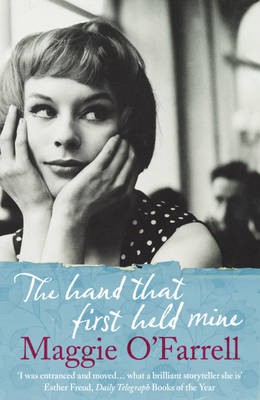You have no items in your cart. Want to get some nice things?
Go shopping
Moving and bitterly sweet, The Hand That First Held Mine is Maggie O’Farrell’s fifth novel and winner of the 2010 Costa novel award. Exposing the fragile nature of our human relationships, O’Farrell’s novel paints two compelling portraits of women separated by fifty years.
O’Farrell’s novel cuts between two timelines; following the life of beautiful and headstrong Lexie as she struggles to find her place in 1950’s Soho alongside a haunting depiction of Elina’s attempts to cope after the traumatic birth of her first child. Effortlessly constructing the tales of these two women, O’Farrell calls into question the relationship we assume to be the most stable of all, that of mother and child. Although the connection between the two women isn’t revealed until the very end, these two storylines are seamlessly sewn together throughout. Whilst Lexie falls helplessly in love, Elina battles with the bumpy terrain of motherhood. Lexie’s chapters are dynamic whilst Elina’s sections, though intensely absorbing, are disorientating; as Elina cautiously navigates the first few weeks with her child, O’Farrell creates gaps in the narrative which leave us reeling. As Lexie’s life and loves are told in fast forward, her vibrancy set against the static nature of Elina’s chapters, with painful empathy we, like Elina, feel confused and overwhelmed.
O’Farrell’s honest depictions of life’s darknesses and pleasures are at times almost too poignant to read (her depiction of Lexie’s suffocation after returning from university verges on painful for a soon-to-be graduate!) We are led through Ted and Elina’s story at the same pace as they are, acutely aware of the gaps in our own knowledge. But in Lexie’s chapters the narrator intriguingly hints at her fate. Leaving us uncomfortably more knowledgeable than our loveable protagonist, we know from the beginning that she is heading for disaster: “She has no idea that she will die young, that she does not have as much time as she thinks. For now she has just discovered the love of her life, and death couldn’t be further from her mind”.
As O’Farrell herself has recognised, there are more than just our two female protagonists in this tale. The Hand That First Held Mine constructs a picture of bohemian Soho as vivid as the John Deakin images that initially inspired O’Farrell to write. Connecting these characters through the streets they walk on and the buildings they enter, London acts as a reminder of the stability of stone and the fleeting nature of our human existence. As Ted goes for coffee in the very same building where Lexie works we are reminded of the way in which each building must house the imprint of its past. The nostalgic portrayal of London is tainted by our knowledge of Lexie’s fate and O’Farrell’s focus on how our capital city has itself changed beyond recognition in a mere fifty years.
Elina’s visit to a John Deakin exhibition cleverly exposes both the connection between O’Farrell’s two main characters and the ultimate reason why this tale is at times so uncomfortable to read. As we see Lexie, our bright and vibrant protagonist, transform into an unidentified woman in a black and white photograph, we are reminded of the inevitable passing of time. Elina describes Deakin’s photography of 1950’s Soho as being “kind of melancholy…because they capture something that’s gone” and I think that O’Farrell’s novel could be described in the same way. Littered with references to loss and the unreliability of memory, The Hand That First Held Mine forces us to question our own fragile existence. Just as Lexie’s ghost haunts Elina’s London, this novel will stay with you long after you have finished its last page.
The Hand that First Held Mine is published by Headline Review, RRP £7.99.




